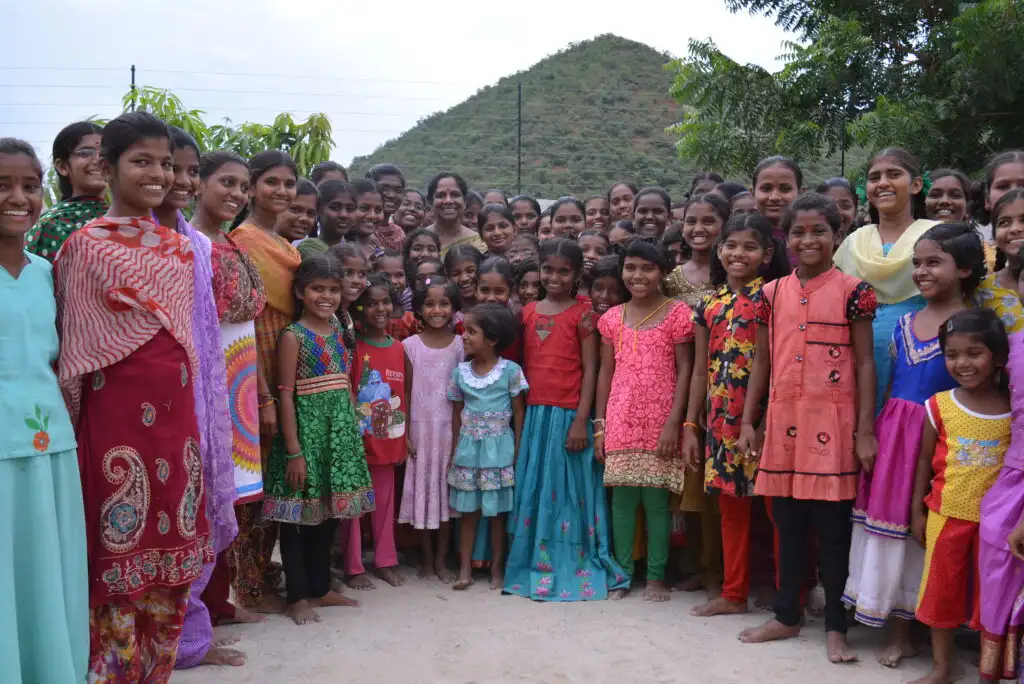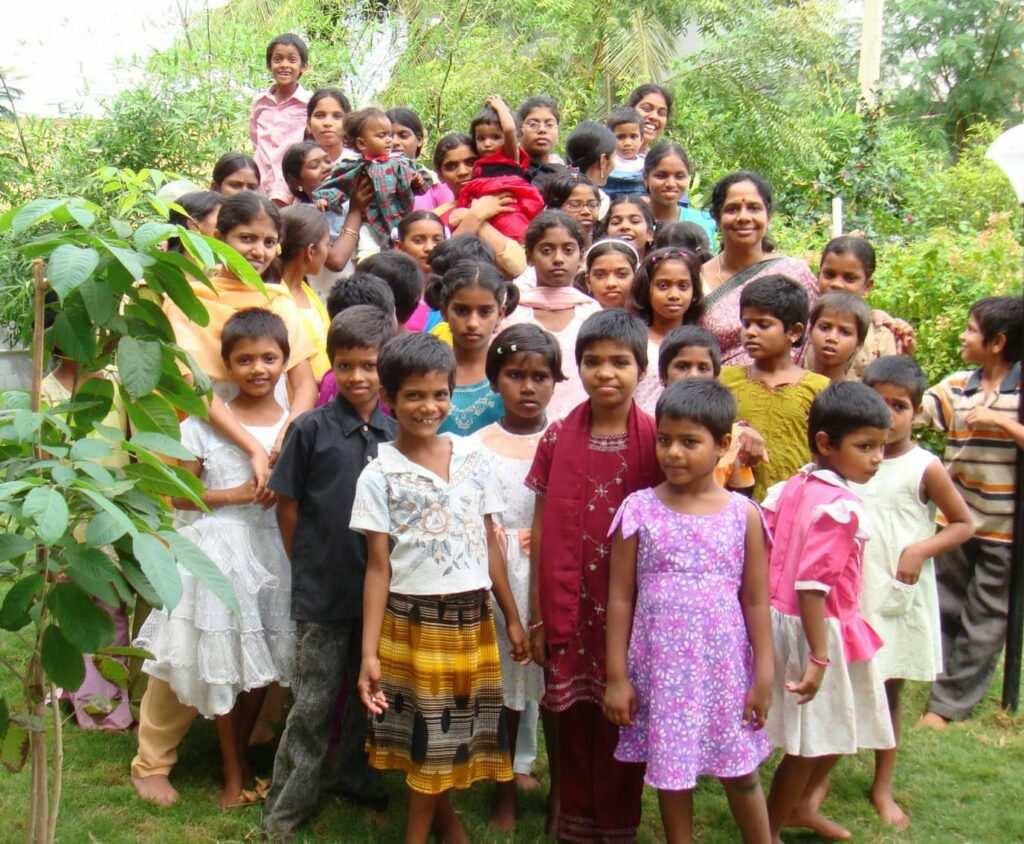Creating a Future : An NGO that is single-handedly salvaging children from a brutal society

Meet Sandhya Puchalapalli, the founder of Aarti Home, a network of individuals committed to responsible citizenship and upliftment of the girl child. Canta Dadlaney travels back in time with Sandhya to discover how she single-handedly took up the cause of the girl child and educated the town of Kadapa which experienced massive abortions and domestic abuse.
Kadapa District – No place for the fairer sex:
Circa 1977 – Sandhya Puchalapalli arrives in Kadapa with her husband and two young daughters, one a 4-year-old and the other just 7 months.

In Kadapa, as in India, the child sex ratio has always been abysmal. 1 in 10 girls are not allowed to live beyond the age of 5. This is visible through the countless crimes inflicted on them, be it child marriages, domestic abuse or overnight disappearances.
The acute poverty of Kadapa and the domestic abuse of women were glaringly conspicuous. A teacher by profession, Sandhya hardly saw any girls in the school she taught. Abortions were a vicious second nature in families where the girl child was ‘unwanted’. They were forced into domestic labour or were left to the mercy of the night. Shaken by misery, Sandhya started looking for ways to alleviate the plight of the girl child in Kadapa. Many years later today, the district wears a drastically different look, thanks mostly to Sandhya’s work and her organisation.
Excerpts from a chat:
What prompted your decision to do something about the dire situation in Kadapa?
My father was an irrigation engineer and we were transferred to different cities. I had witnessed similar issues though less severe, even during our travels but the brutality in Kadapa was unbelievably inhuman. It was heart-wrenching to see how men beat their wives and girls were deprived of education. The violence and abuse did not deter me from speaking to people. At the onset, I voiced my concern with a few people and was relieved that they were ready to extend support. I was a young mother with two kids and it takes people to welcome someone who wants to bring about a change especially if it’s a small town like Kadapa.
How did the organisation take root?
I became very active in 1991 when our washerman shared details about a girl abandoned on the roadside. I rushed there to get her home. I later learnt from the washerman, that the girl’s Dad had pushed his wife into a well to die and left his daughter to fate. A similar incident took place in 1992. It was a very hot summer day and I was informed about a little girl, Radhika who had been left on the streets. I took Radhika home, discussed with my family and everyone amicably agreed that we would henceforth rescue such kids and bring them up as our own. Today, Radhika is a radiology technician in the National Thermal Corporation. In our own limited way, we set goals to reach out to families to help women and rescue girls. My teenage nieces who were in the US visited us and shared ideas about raising funds. At that point of time, unfortunately, I lost my niece, Aarti and I decided to name the home we built after her.
You were married, with two little ones of your own. What sort of resistance did you face?
Well, the reactions ranged from ‘Let me support the best I can’ to ‘Does she know what she’s doing? It’s a lifelong commitment’. We nose-dived into this without any thought of a downslide. I believe that if you really want to make a change, you need to think only in one direction, the positive one. My husband continues to be my main strength and key advisor. Our extended families were the staunchest supporters giving us the much needed financial and emotional support.
The process of building from the ground up must not have been easy. Talk to us about your growth.
In the first year of operations, Aarti Home had rescued ten children which soon became 30. We managed to raise funds and purchased land from the government and bought a new place in 1996. However, the abandonment continued, unabated. We found infants in trash cans, in a state where rescue made no sense. These are scenes I can never forget. We then created a crib outside our home for people to have the sense to leave their kids in a more dignified manner. We also managed to arrange for a ‘child helpline’ in the district to rescue abandoned children.
What does the home look like today?
The complex is home to 125 children accommodated in 12 cottages in an environment reminiscent of a normal family. Over the years, it has been a home for more than 1200 children and for 5600 for short-term care. Most of them are engineers, data scientists, medical professionals and even entrepreneurs. Aarti Home also supports 550 children through a family-based care initiative where kids are provided with all the support including education, three meals a day, hygiene and social security assistance.

What are some of the issues the kids have had to face?
Every experience brought new challenges. We discovered that our children, who went to mainstream schools were struggling because of uneven beginnings in their education and went into a shell of their own. Bridge schooling was a start, but we understood that we needed to change the way our children were taught. In 2006, we started Aarti School, which today facilitates 640 children and is known for its innovative and holistic teaching.
What are some of the grassroots solutions you’ve tried to find to this issue?
There was no stopping the abandoning of girls. That made us research more into the reason behind women discarding their own daughters. It was usually the men taking that call and the women were powerless. This set the pace for training women. As I speak, we have trained more than 40,000 women in vocational skills. Once empowered, they are able to stand up for themselves. We have also created support groups across the district for women to help each other. Our empowerment efforts have found a voice in the surrounding 1300 villages. We’ve had volunteers from Stanford who played a key role to garner global assistance. A documentary was created for the BBC and put us on the global map.
In the field now for so many years, the task must have been onerous. Are there any specific stories that have kept you going?
In 2001, Sowmika was left at the doorstep of Aarti Home. As a student, she excelled in her studies. I longed to see her work in a multi-national but she told me she will work for the Mana Bidda project. “I was abandoned. I don’t wish to see anyone else experiencing the same”, she told me. To be orphaned is painful but to be abandoned hurts and scars.
Parveen, a very brave young girl surmounted all barriers of family, religion, community, and society and through our job-training courses, became a flawless seamstress. One day, she visited me, unable to restrain her joy. She told me “Today, when I returned from work, my mother-in-law gave me tea!” It might seem trivial, but that is a level of respect and acknowledgement that these women have never experienced. The wheels of justice were moving in the right direction.
Over the years, the home has received a lot of recognition. What among these have mattered the most to you?
On National Girl Child Day, we had organised a competition for schools. On the last day, prizes were awarded to the winners. A 13-year old boy who topped the competition told me, “I will go the Aarti way,” and offered his entire prize money to Aarti Home. That acknowledgement meant a lot to us, and coming from a young teenager overwhelmed us all!
Aarti Home has been accredited by Give India and has won admirable support from the European Commission. We have had foreigners spending two months with us, working selflessly and returning richer in their experience of human service. They return home with a promise of garnering more support for us and that is rewarding in itself.
What was covid like for your organisation?
Even before the lockdown of 2020 came down on the citizens, Aarti Home went out on a limb educating all about the importance of social distancing. This was done via huge banners, about a 1000 which carried the message of hygiene, the virus and precautions. Aarti Home distributed three different types of packages catering to different sections of society. These included a sanitation relief pack of cleaning supplies and masks, a dry ration relief pack for families desperate for assistance and Covid-19 kits for quarantined patients. A majority of the essential workers in Kadapa wear masks made by the women of Aarti Home.
Where do you see the organisation headed in the future?
The state government offers scholarships to our outstanding students. My daughter is a doctor and my son runs a travel agency. Our individual networking has helped us form alliances with like-minded people, organisations, help groups, corporates, schools and volunteer communities all of whom have played a big part in strengthening our vision and establishing a brighter and positive future for these girls.
- Mana Bidda Project:
Soon after the Prime Minister launched the Beti bachao, Beti Padao’ scheme. We started the Mana Bidda project, which stands for ‘Any child is our child; girl or boy.’ I used to visit every single household and counsel them on female feticide, the importance of educating girls, on treating daughters on par with sons, and to stop aborting because eventually it impacts a woman’s health too.
- Aarti Home Factfile:
– rescued more than 1200 children
– trained more than 40,000 women in vocational skills
– supports 550 children through a family-based care initiative
– provided short-term care to 5600 children
– runs a child helpline in the district
- “To be orphaned is painful but to be abandoned hurts and scars.”
- Leading Change : “That girls are a burden, is a stubborn mentality and we need to change that. We need to increase the numbers of women in the workforce. Three decades and now we are seeing the tide slowly turn”
Two Videos
Heritage Sandhya – https://youtu.be/GBq3tQH8Hwo
BBC Documentary – https://youtu.be/iAFzDCimZXk
Ad














